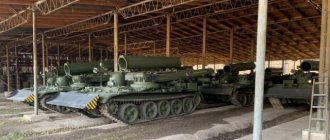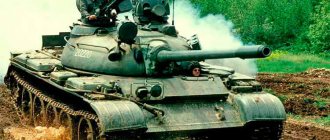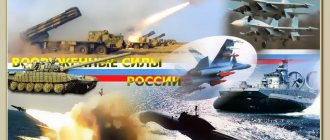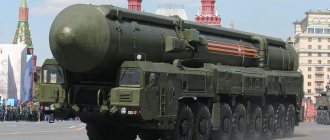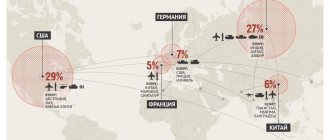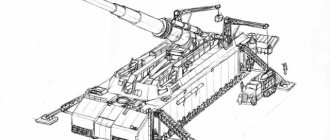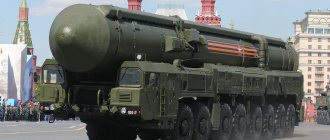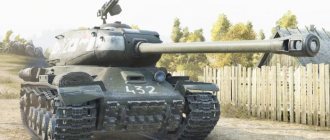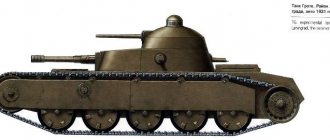An infantry fighting vehicle of the 2nd development (armed forces of the USSR/Russia and a number of other countries), was designed to replace the BMP-1. The reason for the creation of a new vehicle was the need to change the weapon system, especially the 73-mm 2A28 smoothbore cannon, which turned out to be ineffective in the fight against infantry and low-flying air targets. As a result, a new 30-mm automatic cannon, manufactured at the Tula Machine-Building Plant, and the Fagot or Konkurs anti-tank missile system were installed.
The new infantry fighting vehicle was put into service in 1977, and operation began in the eighties of the twentieth century.
History of creation
After the BMP-1 entered service, a debate arose among the leadership about the composition of the necessity and sufficiency of the firepower of this vehicle. The main armament was the 73-mm 2A28 “Thunder” cannon, which was installed to combat armored vehicles; the combat vehicle’s ammunition load contained only anti-tank cumulative shells.
Tests have shown that this weapon is not effective either against infantry or enemy equipment, so they began to create experimental combat vehicles with a new set of weapons.
In the 70s, a prototype combat vehicle appeared under the designation Object 768, which provided for an increase in the firepower of the Thunder cannon. A modification of the 73-mm smoothbore gun "Grom" was named 2A41 "Zarnitsa" and was installed on the experimental vehicle. But Object 768 did not enter service with the army. At the same time, Object 681 was created with the same weapon system, but work on the project was soon stopped.
In parallel with these experimental vehicles, new versions of infantry vehicles with a completely new type of weapon were proposed - the installation of a 30-mm automatic cannon (2A38/2A42).
The proposal came from Kurganmashzavod. The first vehicle with the new weapons was called Object 680 with a 2A38 automatic cannon. The second, object 675 with a 2A42 automatic cannon. Military experts did not take the new inventions seriously, believing that this weapon system was not effective due to its small caliber.
Attitudes towards new experimental combat vehicles changed radically with the start of hostilities in Afghanistan. It became obvious that Object 675 was indispensable in the combat conditions of Afghanistan. Thus began the history of the infantry fighting vehicle under the designation BMP-2.
Armored vehicles in Afghanistan (1979-1989) - part 1
Introduction
Analyzing the publications of periodicals and major works on the Afghan war of 1979 - 1989, it can be noted that the main characters who attract the attention of the authors are special forces, paratroopers, helicopter pilots, sappers, and finally, motorized riflemen. Tankers and crews of other armored vehicles are usually mentioned in passing, in connection with the combat activities of other branches of the military. There are objective and subjective reasons for this.
With this work we want to restore justice by highlighting, as far as possible, the features of the combat work of armored vehicles in Afghanistan.
The divisions of the Turkestan Military District that entered Afghanistan had a staffing and organizational structure that differed very little from the structure of similar formations in the European theater of operations. Initially, the motorized rifle divisions, as expected, included tank regiments:
• 234th Tank Regiment in the 201st Division;
• 24th Guards. tank regiment in the 5th division;
• 285th Tank Regiment in the 108th Division.
In total, taking into account the tank battalions of motorized rifle divisions, by 1980 there were 39 tank battalions in Afghanistan. However, already in June 1980, the 234th Tank Regiment was withdrawn to the Union - there was no one to fight tank battles in Afghanistan with. The 40th Army retained the 285th Tank Regiment of the 108th Motorized Rifle Division, stationed in Bagram, and the 24th Guards Prague Order of Suvorov and Bogdan Khmelnitsky Tank Regiment of the 5th Guards Motorized Rifle Division, stationed in Shindand. In March 1984, the 285th Tank Regiment was reorganized into the 682nd Motorized Rifle Regiment, and the total number of tank battalions was reduced to 17. In October 1986, the 24th Guards was also withdrawn to the Union. tank regiment General Gromov justified this step as follows: “... in the mountains, tankers could not fully, with maximum effect, use the combat capabilities of their vehicles. In the green zone, the tanks literally got stuck in the rice fields. As a rule, they were used only for protecting objects and during operations on small plains where vehicles could turn around. To carry out combat missions there were enough tank battalions, which were located in the staff of motorized rifle units...”
Tank battalions were part of the 180, 181, 177, 682nd regiments of the 108th Motorized Rifle Division, 149, 122, 395, 191st regiments of the 201st Motorized Rifle Division, 12, 371, 101st regiments of the 5th Guards. motorized rifle division, 860th separate motorized rifle division, 66th and 70th separate brigades. In addition, the 103rd Airborne Division had its own tank units.
Tank commanders, gunners and driver mechanics for these units were trained in Termez, where the 108th Motorized Rifle Division was located before the war. The loaders arrived immediately after the young soldier’s course and mastered their simple specialty directly in the unit.
According to the standard organization, a tank regiment consisted of three tank battalions, each of which included three tank companies from three tank platoons. The platoon consisted of three tanks, so the company, including the tank of the company commander, had 10 tanks. The battalion commanders and regiment commander had command versions of tanks, so the battalion consisted of 31 tanks, and the regiment had 94 vehicles.
The tank battalion of a motorized rifle regiment (brigade) was distinguished by the fact that tank platoons consisted of four vehicles, therefore, the battalion should have had 40 tanks.
Thus, if we take as the basis for the calculation the regular strength of a tank regiment and a tank battalion of a motorized rifle regiment, then until June 1980 the 40th Army had approximately 800 tanks, from June 1980 to 1984 -700 tanks, from 1984 to autumn 1986 - 650 tanks, from autumn 1986 to 1989 - 560 tanks. However, this calculation is not entirely accurate for two reasons.
Firstly, the units were never 100% staffed. Tanks failed both due to combat damage and for technical reasons; repairs on site were not always possible and not everywhere. We had to wait for the cars from the Union to arrive, which was fraught with certain difficulties.
Secondly, even the airborne units in Afghanistan had their own tanks, which they were not entitled to. The number of these combat vehicles could vary, so the above data is very average. So, in reality in 1988 there were 580 tanks in the 40th Army.
In addition to tanks, lighter armored vehicles were widely used during combat operations - armored personnel carriers BTR-60PB, BTR-70, BTR-80; infantry fighting vehicles - BMP-1 and BMP-2; airborne combat vehicles - BMD-1 and BMD-2; armored reconnaissance and patrol vehicles BRDM-2; multipurpose transporters MT-LB.
In total, 12 motorized rifle regiments, two motorized rifle brigades, four parachute regiments and one air assault brigade had about three thousand light armored vehicles. According to the data given in the book by I. Drogovoz (the source of information, unfortunately, is not specified), in 1988 the 40th Army had 388 infantry and airborne combat vehicles and 2888 armored personnel carriers.
Finally, the ZSU-23-4 anti-aircraft self-propelled guns, the IMR-1 engineering clearing vehicles, the BMR-2 mine clearing vehicles, and the BTS-2 and BTS-4 tank tractors were used.
Chapter 1. Armored vehicles of the 40th Army and its improvement during the fighting in Afghanistan
Initially, the tank units of the 40th Army were armed with T-55 tanks. But, as General Gromov recalled, in anticipation of military operations, from January 1980 the troops began to receive T-62 and T-64 tanks. The latter, however, did not withstand the tests at high altitudes: the two-stroke diesel engine failed, and they did not stay long in the DRA. But the T-55 and T-62 fought in the mountains for quite a long time.
The T-55, which entered service in 1957, was created at the Design Bureau of the Ural Carriage Works in Nizhny Tagil under the leadership of L.N. Kartsev and was the result of a comprehensive modernization of the T-54 tank. The tank was built in Nizhny Tagil and Omsk, and by the time troops entered Afghanistan, production had already ceased.
The T-55 was a medium tank with a classic layout. The tank's crew consisted of four people: a tank commander, a gunner, a driver and a loader. In this case, the commander, gunner and loader were located in the fighting compartment, the first two in a tier to the left of the gun breech, the loader to the right. For ease of operation, the loader's seat was made folding, and the floor of the fighting compartment rotated along with the turret. The driver was located in the control compartment in front on the left along the direction of the car.
The tank's hull was welded from rolled armor plates; the frontal plate had a thickness of 100 mm and an inclination angle of 60 degrees. The sides were made vertical from sheets 80 mm thick. The hemispherical turret was cast, the thickness of the front walls reached 200 mm along the normal, and 170 mm on the side walls.
The main armament of the tank was a 100-mm D-10T2S cannon and a coaxial 7.62-mm PKT machine gun, installed in the turret embrasure. The gun was stabilized in two planes by the STP-2M “Cyclone” stabilizer, and the gunner fired from it using a TSh-2B-32 day telescopic sight of variable magnification or a TPN-1-22-11 night active infrared sight. The "Luna" headlight with an infrared filter was located above the gun on the right. The gun's ammunition included 100-mm unitary rounds with armor-piercing sub-caliber, armor-piercing, cumulative and high-explosive fragmentation shells. In the conditions of Afghanistan, the first three ammunition were practically not used and the ammunition consisted, as a rule, only of high-explosive fragmentation shells. Unlike the T-54, the vehicle received fuel tank racks, which made it possible to increase both the fuel supply and the ammunition load. In addition, in the control compartment to the right of the driver, another 7.62-mm PKT machine gun was fixedly installed, the fire from which was fired by the driver himself using an electric trigger. Aiming was carried out by turning the entire machine. Finally, since 1973, the T-55 also began to be equipped with 12.7-mm DShKM machine guns, which were placed on an open turret above the right hatch. The machine gun had to be fired at air and ground targets by the loader, using either an anti-aircraft collimator sight or an open sector-type mechanical sight. In addition to these weapons, the tank was equipped with storage for an AKM assault rifle and F-1 grenades.
The power plant used was a 12-cylinder four-stroke V-shaped liquid-cooled diesel engine B-55, installed across the hull and producing 580 hp. Unlike the T-54, a new two-stage air cleaner VTI-4 was used and an air compressor was installed on the engine crankcase, which made it possible to make air starting the main one. The torque was transmitted through the guitar to a five-speed gearbox, and then through planetary turning mechanisms and final drives to the aft drive wheels. The undercarriage of each side included five large-diameter road wheels, a guide wheel and a drive wheel. The suspension of the rollers was torsion bar, with hydraulic shock absorbers on the first suspension units; the caterpillar had an open metal hinge, a lantern engagement and developed lugs.
Communication was provided by the R-123 VHF radio station and a tank intercom. A fire extinguishing system was also installed, based on thermal contacts and carbon dioxide cylinders. The system was activated by the crew upon receiving light and sound signals about a fire.
The T-62 was created at the same Kartsev Design Bureau and entered service in 1961. Production of the tank at Uralvagonzavod was also discontinued by 1979. Compared to the T-55, the following changes were made to the T-62:
• smooth-bore semi-automatic 115-mm cannon U5TS (2A20) with a two-plane stabilizer 2E15 “Meteor”, an automatic ejector for spent cartridges and a TSh-2B-41 sight;
• hemispherical solid-cast turret with a ring diameter increased to 2245 mm;
• tank hull increased by 368 mm in length and 27 mm in height;
• changed distance between suspension units;
• minor design modifications to components and systems of the tank.
From a technical point of view, these tanks performed well. The four-stroke diesel engine, which had been used for decades, worked quite steadily both in the mountains and in the deserts of Afghanistan. The fine dust, which was a real curse, quickly clogged the air cleaner's screens and cyclones, but its maintenance was not particularly difficult. In the summer, driver mechanics especially had to monitor the temperature conditions of the engine, since operation in low gears at high ambient temperatures led to overheating of the power plant. On mountain roads, the service life of the chassis, especially the tracks, was significantly reduced, but since the troops were based in one place and did not move, as in the “big war,” it was always possible to carry out maintenance and repairs in a timely manner. The greatest difficulties for tank crews were the climatic conditions of Afghanistan. Air conditioners were not installed on Soviet tanks, and a couple of low-power fans and open hatches could not save the situation. At air temperatures close to 30 degrees above zero, the inhabited compartments of the tank turned into open hearth.
There were practically no complaints about the armament of the tanks - 100-mm and 115-mm high-explosive fragmentation shells had a sufficient effect on unprotected manpower, and there was essentially no armored enemy in Afghanistan. The machine guns worked reliably in highly dusty conditions, however, on marches it was necessary to protect the barrels from dust, for which savvy tank crews adapted plastic bags: it protects from dust and does not interfere with firing. The main disadvantage of tank weapons in mountainous conditions was the small elevation angles of the main weapons, which did not allow firing at the enemy on the upper tiers. Anti-aircraft DShKMs installed above the loader hatches had the required angles, but they did not have remote control, and to fire, the tanker had to go out from behind the armor cover.
However, the main disadvantage of Soviet tanks was their poor protection against mines and cumulative ammunition. Actually, this was not a discovery for designers and the military: even during the Arab-Israeli wars in 1967 and 1973, tanks of the T-54/55 and T-62 types were easily hit by ATGMs and RPGs. However, in a “correct” field war, tanks almost always had freedom of maneuver, the ability to use the entire firepower of their own and assigned units against identified anti-tank weapons. In the end, the sheer variety of combat situations rarely led to a tank-RPG or tank-ATGM duel. In this regard, shortcomings in the protection of Soviet vehicles in the Middle East were compensated by a number of advantages: a low silhouette, good mobility over the sand and sufficient firepower.
Another thing is Afghanistan. Here the tanks had no other enemy except a single Mujahideen with a grenade launcher and mines that littered the roads. There was practically no freedom of maneuver, and even where the terrain allowed leaving the road, this was in most cases impossible, since the roadsides were densely mined by the enemy. Finally, the attack itself was carried out by the Mujahideen where the crew’s visibility was reduced to a minimum - in mountain defiles, in the green zone or among the remote duvals of villages. Major General Lyakhovsky, assistant to the head of the Operational Group of the USSR Ministry of Defense in the DRA, recalled: “... the tanks ... in most cases “did not find” operational space for their use, could not fire at the tops of the mountains, got stuck in the “green stuff” and often became useless in battle ..."
All this led to the fact that the crew at the combat exit could at any moment expect a cumulative grenade on the side or a landmine explosion under the caterpillar. In such a situation, one had to rely only on armor protection, and that was precisely what failed.
The relatively thin armor of the sides, roof and stern was easily penetrated by an RPG-7 grenade. Having armor penetration of about 400...500 mm, the grenade launcher could hit a T-55/62 type tank head-on. Despite the relatively weak armor effect, when a cumulative grenade hit the turret, as a rule, it killed one or more crew members, could disable the weapons, and undermine the ammunition load. A hit in the engine compartment made the car a stationary target, and if fuel lines were encountered along the path of the cumulative jet, ignition occurred. Tank commander Sergeant V. Rusnak recalled: “It’s very scary when a cumulative shell hits a tank. “Burns through” armor anywhere. If the hatches in the turret are open, then a huge pressure force throws people out of the tank...”
Of course, there were happy exceptions, for example, when the T-55 turret was hit by 7 RPG grenades, they all pierced the armor, but the crew remained alive and the tank was combat-ready.
Unfortunately, not everyone was so lucky: in 11 months of 1980, 16% of tank losses occurred from RPG fire. Brief performance characteristics of tanks
| Characteristics | Car names | ||
| T-55 | T-55A | T-62 | |
| Year of creation | 1958 | 1962 | 1961 |
| Crew, people | 4 | 4 | 4 |
| Weight, t | 36,5 | 38 | 37,5 |
| Dimensions, mm: | |||
| – body length | 6040 | 6200 | 6630 |
| – length with gun forward | 9000 | 9000 | 9335 |
| - width | 3270 | 3270 | 3300 |
| - height | 2218 | 2350 | 2395 |
| – ground clearance | 425 | 425 | 430 |
| Booking, mm: | |||
| – body forehead | 100 | 100 | 100 |
| – hull side | 80 | 80 | 80 |
| – tower forehead | 200 | 200 | 200 |
| – tower side | 170 | 170 | 170 |
| Weapons: | |||
| – brand of gun | D-10T2S | D-10T2S | U5-TS |
| – caliber, mm | 100 | 100 | 115 |
| - machine gun | SGMT | PCT | PCT |
| – caliber, mm | 2 x 7.62 | 7,62 | 7,62 |
| – anti-aircraft machine gun | DShKM | DShKM | DShKM |
| – caliber, mm | 12,7 | 12,7 | 12,7 |
| Ammunition: | |||
| – shots to the cannon | 43 | 43 | 40 |
| – 7.62 mm cartridges | 3500 | 2750 | 2500 |
| – 12.7 mm cartridges | 400 | 400 | 400 |
| Aim | TSh-2B-32 | TSh-32PV | TSh-2B-41 |
| Engine | B-55 | B-55 | B-55V |
| – power, hp | 580 | 580 | 580 |
| Specific power, hp/t | 16,1 | 15,2 | 15,4 |
| Speed, max, km/h | 50 | 50 | 50 |
| Cruising range, km | 480 | 480 | 450 |
Anti-tank mines and land mines posed an even greater danger. Losses from mine explosions for the same period in 1980 amounted to 59% of the total. Of the total number of tanks that exploded, 17% were lost forever or required major repairs. An explosion under one of the tracks not only tore it apart, but depending on the power of the charge, one or more road wheels and suspension units were torn off. The impact of the explosion on the bottom led to its deflection, or even a break, concussion or death of the crew. The authors of the textbook on military field surgery, Fr. The main damaging factor was a sharp drop in pressure inside the combat vehicle, which led to severe injuries to the skull, spine and internal organs, open and closed fractures, destruction and separation of limbs. In addition, internal equipment torn from its mounting points or destroyed created a stream of secondary fragments.
Hero of the Soviet Union, driver-mechanic S. Igolchenko, who was blown up six times during a year and a half of service, recalled: “... one of the lessons of Afghanistan: the tank crew is on the armor while moving. Except, of course, the driver. It is correctly said: the bullet is a fool. It may catch, or it may miss. A mine or landmine is another matter. If the crew found themselves in an explosion inside a tank, you wouldn’t envy the guys. And so, it will only shake you and throw you to the ground. The mechanic has nowhere to go; his place is in the womb of the car. An undermining is a disaster for him...” The use of mine trawls did not always ensure safety. Knife trawls were useless on rocky soil, and various tricks were used against the Katkovs: radio control, gradual detonation of the fuse (the landmine exploded not under the trawl, but sometimes in the middle of the column) and many other methods of mining.
Thus, already the first operations resulted in significant losses in military equipment. During 1979 - 1980, the 40th Army irretrievably lost 19 tanks, several times more were knocked out, but then restored by repair companies and battalions. Strengthened protection was required, and the troops began their own improvisations: hanging boxes with ammunition, sand and crushed stone, spare road wheels, caterpillar tracks, tanks with water, oil and fuel on the armor; they even welded track fingers onto the armor at the ends, turning the tank into a “hedgehog” "
In May 1980, leading weapons designers came to Kabul and received complaints and wishes regarding military equipment, after which the matter was put on a production basis and most of the tanks were equipped with additional protection at overhaul factories. Rubber-fabric screens were hung on the sides of the hull; An additional metal-ceramic block was installed on the frontal part in the form of a box-shaped structure made of 30 mm thick armor sheets, inside of which 5 mm steel sheets were placed with 30 mm gaps filled with polyurethane foam. “Eyebrows” of a similar design were hung on the front of the turret to the right and left of the gun.
However, the measures taken did not significantly reduce the dynamics of losses; in 1981–1982, another 45 tanks exploded or burned. Therefore, in the early 80s, a lot of research work was carried out on the deep modernization of the T-55 and T-62. In May 1982, a group of designers and plant directors headed by the head of the GBTU, Colonel General Potapov, visited the DRA again. And in March 1983, the modernized T-55M, T-55AM and T-62M were put into service. They were equipped with enhanced mine protection:
• a cellular frame on the bottom of the hull under the habitable compartments made of steel channel or angle steel 80 mm thick, covered from below with six armor plates 20 mm thick;
• spacer pillar-pillar in the control compartment behind the driver to prevent bottom deflection during an explosion;
• special fastening of the mechanic's seat on a floor, welded to the side and having a gap of 30 mm with the bottom of the hull, so that the explosion energy does not act directly on the seat;
• a casing over the first pair of torsion bars with a 20-mm rubber mat to protect the mechanic’s feet, an emergency hatch cover reinforced with 20-mm armor plate.
In addition to the already introduced anti-cumulative protection measures, steel lattice screens were installed on the sides and stern of the hull and turret, which destroyed RPG grenades without detonation.
Improved protection against incendiary weapons by installing fine-mesh protective mesh on the transmission roof and protective steel tubing for external electrical wiring. The modernized tanks were equipped with a new “Volna” fire control system with a guided weapons complex and a 902B “Tucha” smoke grenade launch system. The mass of the modernized vehicles exceeded the 40-ton mark, and it was necessary to install a boosted one up to 620 hp. engine. The chassis has been improved. They introduced reinforced rubber-metal hinges and track lugs, new torsion shafts, and hydraulic shock absorbers on the second pair of road wheels of T-62 tanks.
T-62M tanks were armed with the 24th Guards Tank Regiment of the 5th Guards Motorized Rifle Division, stationed in Shindand.
In addition, there was a search for active methods of protecting tanks, which resulted in the creation of modifications T-55AD and T-62D. These vehicles were equipped with all the improvements of the T-55AM (62M), except for the additional armor of the hull and turret, and the 1030M Drozd active protection system, created jointly by NIistali and Kolomna Design Bureau, was installed. General designer of the Kolomna Design Bureau S. Nepobedimy recalled: “... it is known that many types of weapons in the mountains turned out to be ineffective. Although no special tasks were set for us, I suggested that D.F. Ustinov allocate funds for the development of a system specifically designed for Afghan conditions. The Ministry of Defense agreed with my proposal. In a short time, the design bureau completed, so to speak, an above-plan task and delivered a batch of weapons to the limited contingent of Soviet troops, which immediately showed their high efficiency...” The system was put into service in 1987 and ensured the destruction of two anti-tank ammunition flying at a speed of 70 to 700 m/s in each sector of 20 degrees from the longitudinal axis of the tank. Detection of approaching objects was carried out by two mm-range radars; the destruction was carried out at a distance of 6.6 meters from the tank by a stream of fragments formed when a 107-mm ZUOF-14 round was detonated. Readiness for repeated action was ensured in 0.2 seconds, the mass of the kit was only 600 kilograms. When testing the Drozd, at the final stage, a Mi-24 helicopter was used, which fired at a T-55 tank with the Drozd system with Phalanx anti-tank guided missiles. None of the missiles hit the target; all of them were destroyed by the Drozd system on approach.
It must be admitted that modernization in this case did not lead to a drastic reduction in tank losses. The enemy began to use only more powerful landmines. S. Igolchenko, mentioned above, recalled one of the explosions: “The explosion turned out to be impressive. Our “baby elephant” had its bottom torn out, all its insides were cut by shrapnel, even the dashboard was damaged. I was lucky again - I was just stunned...” The dynamics of losses depended more on the intensity of hostilities than on technical improvements.
As we can see, the ratio of irretrievable losses in tanks to irretrievable combat losses of personnel during the war was at an average level of 0.01 tank per dead person. A decline in losses was observed in 1984 and 1987 to 0.002 and 0.005, respectively, an increase in 1981, 1988 and 1989, especially significant, to 0.03 in 1988-1989. In relation to the total number of tanks of the 40th Army in 1988 (580 units), irretrievable losses in 1988-1989 amounted to 4.14%.
A certain idea of the ratio of irretrievable losses of tank crews to total losses is given by a table compiled from data on dead natives of the Sverdlovsk region (see Table 4).
It is significant that of the eight Sverdlovsk tank crews who died, only two died directly in their combat vehicles: the driver mechanic in the 181st motorized rifle regiment was hit by an RPG grenade in the tank, and the gunner in the 177th motorized rifle regiment died from a direct hit of a mine in an open tank hatch.
Modernization during the Afghan war gave impetus to the search for ways to further strengthen the T-54/55 and T-62 tanks, which in 1988 accounted for 36.5 and 26.7% of the USSR tank fleet, respectively. It was aimed mainly at improving security by installing dynamic or active protection and increasing firepower.
The motorized rifle units of the 40th Army were initially armed with armored personnel carriers BTR-60PB and BTR-70, reconnaissance patrol vehicles BRDM-2 and infantry fighting vehicles BMP-1. We are forced to include the ZSU-23-4 “Shilka” self-propelled anti-aircraft gun in this same group, which in Afghan conditions did not have air targets and was used for direct fire at ground targets.
The BMP-1 was created by the SKB Chelyabinsk Tractor Plant under the leadership of P.P. Isakov on a special tracked base and entered service in 1966. Serial production of the machine was organized at the Kurgan Machine-Building Plant.
The combat vehicle had a characteristic boat-shaped body, welded from rolled armor plates with a thickness of 6 to 26 mm. According to calculations and experimental firing, the 26 mm thick frontal armor, which has large angles of inclination, was supposed to withstand hits from 23 mm armor-piercing shells from 500 meters, and 6 mm side armor - from a 7.62 mm armor-piercing bullet from 75 meters. In the bow of the hull there was a motor-transmission compartment, to the left of which there was a control compartment in which the driver worked. Immediately behind him was the commander of the vehicle. The conical turret, which housed the gunner-operator, is located in the center, and the landing force is located in the rear of the hull along the sides. The landing force had the opportunity to fire from personal weapons through loopholes with ball mounts, sleeve stoppers and suction of powder gases. Personnel landed through the aft doors, but could also use hatches in the roof of the hull.
The vehicle's armament complex, in addition to infantry weapons, included a 73-mm smoothbore active-reactive cannon 2A28 "Thunder" with a semi-automatic electromechanical loading mechanism and a 1PN22 periscope sight with day and night branches. The gun was installed in the turret and was paired with a 7.62-mm PKT machine gun. In addition, above the gun mantlet there was a 2P130 launcher for the 9M14 “Malyutka” ATGM in the form of an open guide, which was manually reloaded through a special hatch in the turret. The troop compartment had storage for the RPG-7 or 9K32 Strela-2 MANPADS.
The power plant was a 6-cylinder four-stroke V-shaped diesel engine UTD-20 with water cooling. The engine was mounted in one block with a transmission, which included a main clutch, a five-speed gearbox, two-stage planetary rotation mechanisms and final drives.
The chassis used six single-pitch small-diameter road wheels on a torsion bar suspension and three support rollers on board. To increase the buoyancy reserve, the support rollers were made hollow, and afloat movement was carried out by rewinding the tracks in the hydrodynamic casings of the fenders. To prevent incoming water from flooding the MTO roof and the driver's hatch, a wave-reflective shield was installed on the bow of the hull. A new small-link caterpillar with a double-ridge track and a parallel rubber-metal joint was used, as well as telescopic hydraulic shock absorbers on the first and last suspension units.
The vehicle was equipped with a R-123 radio station with a R-120 TPU, a filter-ventilation unit with a supercharger, automatic fire-fighting equipment and thermal smoke equipment.
In the year of the entry of troops into Afghanistan, a modernized version of the BMP-1P went into production, distinguished by an anti-tank missile system and the absence of an automatic loader. In addition, on the basis of the BMP-1, the BRM-1K combat reconnaissance vehicle was built, which had additional equipment and a turret of increased volume (see Table 5).
The fighting that began immediately confirmed the conclusions from the battle in the Middle East in 1973. The BMP-1 could not withstand hits from 12.7 mm bullets, not to mention RPG grenades. Already on the first day of the Afghan epic, during the assault on the Taj Beg Palace, in which Kh. Amin was located, one of the infantry fighting vehicles participating in the operation was hit by fire from a 12.7-mm DShK machine gun. A hit by an anti-tank grenade, as a rule, caused the vehicle to ignite, followed by an explosion of ammunition. Major I. Blidzhan recalled: “...a volley of three grenade launchers, rising from the wind about two hundred meters away, hit his car. “One, two, three, all three - on board,” I counted to myself... The 22nd car began to smoke, swerved to the right and stopped on the side of the road... the car was burning, and suddenly there was a flash and the roar of an explosion... the explosion was terrible. All that was left on the concrete road was the lower armor plate and, for some reason, the drive wheels...”
Habitability in hot climates was below all standards. BMP driver-mechanic V. Tantsev recalled: “...for us, the BMP crews, it was probably harder than others in the fierce Afghan heat. The sun heated the armor of the vehicles so much that it was impossible to touch it with your hand. So you sit under this armor, as if in a stove, and involuntarily think about our Russian winter. I would go out and wipe myself with snow.” The elevation angles of the weapon did not allow fighting in the mountains; the power and accuracy of the 73-mm gun left much to be desired.
In addition, the BMP did not withstand mine explosions well, and the positions of the driver and commander of the vehicle were located directly next to the left track. BMP gunner-operator N. Kurgan recalled a mine explosion in the spring of 1980 near Jalalabad: “I was dozing off in the operator’s compartment when some force hit my head. I woke up reclining, pain in my head. I get out of the BMP and to the left of the vehicle is terrified infantry. Sergei Bolotnikov bandages the vehicle commander's leg. Tom vomited a piece of meat above the knee. He was lucky that he got out of the BMP and rode on the armor. I shout: “Where is Ruban?” I see that the hatch is closed... I rushed to open it. I lift Seryozha by the arms, but I think to myself that he has become very light, lifted him higher and saw everything. I broke out in a sweat. There were no legs at all. Only the short shin bone remained sticking out from the left leg... there was a huge hole in the bottom. Two rollers were torn out, inside there was a terrible mess of blood, bones, iron, earth...”
An explosion under the right track usually had less tragic consequences. BMP driver-mechanic V. Tantsev recalled: “... there was an explosion. My car was thrown up, the compartment was filled with gunpowder fumes. I jumped out of the car to determine the damage. I saw a hole in the hull, a torn off roller, a broken caterpillar... all this, of course, did not make me happy at all, but the sweat appeared on my forehead for another reason. The explosion occurred on the right side, and I imagined what could have happened if the mine had exploded on the left, where I was sitting at the levers.”
Therefore, since 1982, the 40th Army began to receive BMP-1D, on which steel side screens were hung and the bottom was reinforced under the seats of the driver and commander of the vehicle. Due to the weight, the vehicle lost its buoyancy, which in Afghanistan was an insignificant drawback. The driver mechanics themselves used sandbags placed on the bottom of the control compartment as an improvised means of protection.
In addition, to strengthen the armament of the BMP-1, military craftsmen welded the AGS-17 onto the roof of the BMP-1 turret, thereby compensating for the low fragmentation effect of the 73-mm Grom cannon shells. Taking into account the Afghan experience, the 765sp8 version, or BMP-1PG, was created in Kurgan, on which the AG-17 “Plamya” automatic grenade launcher was installed as an additional weapon.
Design
The BMP-2 is an infantry fighting vehicle that has an identical layout to the BMP-1. The main difference between them is the presence of different weapons. The crew consists of three people. The vehicle can also accommodate up to seven landing personnel, who can fire through the loopholes.
The body and turret of the vehicle are welded from rolled steel sheets, the thickness of which is from 5 to 19 millimeters. The thickness of the frontal armor of the turret is up to 23 mm. The tower has the shape of a truncated cone.
The BMP-2 is equipped with a 6-cylinder diesel engine UTD-20S1 with liquid cooling, the engine weight is 700 kg.
Engine power 300 hp A dry-type double-disc clutch with mechanical control is used. The gearbox is five-speed with synchronizers in the four highest gears. Planetary gearboxes are used to turn the machine.
The chassis has six track rollers, which are a movable support for the body on the caterpillar track. The maximum speed that the car can reach is 65 km/h on the highway and up to 45 km/h when driving over rough terrain. The equipment is capable of independently crossing bodies of water, reaching speeds afloat of up to 7 km/h. Movement through water is accomplished by rotating caterpillars. Because of this, difficulties arise when moving the machine against the current.
The BMP-2 is controlled using a steering wheel with a steering wheel design. Thanks to the free rotation of the steering wheel, control does not require significant effort. When the steering wheel is turned, there is a smooth change in traction on the tracks, which ensures smooth turning and protects the chassis elements from overloads. When the steering wheel is released, control automatically returns to straight-line motion.
The BMP-2 uses the following communications and surveillance equipment:
- internal intercom model A-3;
- radios R-123M, R-173 or R-126;
- surveillance devices TNP-165A or TNPO-170A;
- device for monitoring at night.
The weapons include:
- 30 mm gun 2A42;
- PKT machine gun (Kalashnikov tank machine gun);
- missile system "Fagot" or "Konkurs".
BMP-2 infantry fighting vehicle
BMP-2 infantry fighting vehicle
Created on the basis of the BMP-1 to further improve combat performance. It was developed at the ChTZ Design Bureau since 1972 (object 769) and at the KMZ Design Bureau since 1974 (objects 680 and 675). Adopted by the Decree of the USSR Council of Ministers in August 1980. Serial production at KMZ since April 1980.
SERIAL MODIFICATIONS: BMP-2 (object 675) – the general layout is similar to the BMP-1. In the bow of the hull on the right there is a logistics compartment, on the left there is a control compartment, in the middle part of the vehicle there is a fighting compartment, and in the stern there is a landing compartment. The tower is welded, conical, double. The gun's power supply system is two-belt, which allows you to quickly change the type of projectile - armor-piercing or fragmentation - depending on the nature of the target. The elevation angle of the gun is 74 degrees, firing at air targets can be carried out at altitudes up to 2000 m. Movement afloat is due to rewinding the tracks. The BMP is equipped with PAZ, PPO and protection systems against neutron weapons (top and bottom). On some vehicles, an automatic 30-mm AGS-17 grenade launcher is installed on the turret in an armored casing.
BMP-2D (1982) – reinforced armor (“Afghan” version). Steel side screens on the hull and an armor plate under the commander’s and driver’s workstations. Combat weight 14.5 tons. Does not float.
In April 1980, the first 25 BMP-2s were sent to Afghanistan, where their baptism of fire took place. Until the withdrawal of Soviet troops from this country in 1989, BMP-2 and BMP-2D (“D” - airborne, this vehicle entered service with the airborne assault units of the Airborne Forces) were successfully used by our troops. In the 80s, BMP-2 entered service with the Warsaw Pact member countries. Under Soviet license, production of the vehicle was launched in Czechoslovakia. As of 1995, BMP-2s were in service in Algeria (230 units), Afghanistan, India, Iraq, Kuwait, Slovakia (93), Finland (110), Czech Republic (187), and Sri Lanka.
BMP-2 took part in the Iran-Iraq war. Iraqi troops also used these vehicles against allied forces during Operation Desert Storm. “Twos” fought and are fighting in almost all “hot spots” in Russia and the CIS, including Tajikistan and Chechnya. Based on the BMP-2, the BMP-2K command vehicle is mass-produced.
TACTICAL AND TECHNICAL CHARACTERISTICS OF BMP-2
BATTLE WEIGHT, t: 14. CREW, people: 3. LANDING TROOP, people: 7. OVERALL DIMENSIONS, mm: length – 6735, width – 3150, height – 2450, ground clearance – 420. ARMAMENT: 1 automatic gun 2A42 caliber 30 mm, 1 PU complex 9P135M for ATGM 9M113 “Konkurs” or 9M135M-1 for ATGM 9M111 “Fagot”, 1 PKT machine gun of 7.62 mm caliber, 2 MANPADS 9K34 “Strela-3” (instead of MANPADS, two RPG grenade launchers can be stowed in the vehicle -7), 6 smoke grenade launchers of the 902V “Tucha” system. AMMUNITION: 500 rounds (160 BT, 340 OFZ and OT), 4 ATGMs, 2000 rounds. WEAPONS STABILIZER: electromechanical two-plane 2E36-1. AIMING DEVICES: binocular combined (day, active-passive night) sight BPK-1-42. RESERVATION, mm:6-26. ENGINE: UTD-20S1, 6-cylinder, four-stroke, V-shaped, compressor-free, liquid-cooled diesel engine with jet fuel atomization; power 300 hp (220.8 kW) at 2600 rpm; working volume 15800 cm3. TRANSMISSION: multi-disc main dry friction clutch, five-speed manual gearbox, planetary two-stage turning mechanisms, planetary single-stage final drives. CHASSIS: six single rubber-coated support rollers on board, three rubber-coated support rollers, a front drive wheel with removable ring gears (lantern engagement), a guide wheel; individual torsion bar suspension, hydraulic shock absorbers in the suspensions of the 1st, 2nd and 6th rollers; each caterpillar has 85 tracks 300 mm wide, track pitch 140 mm. MAX. SPEED, km/h: on the highway - 65, afloat - 7. POWER RESERVE, km: 600. OBSTACLES TO OVERCOME: ascent angle, degrees. – 35; ditch width, m – 2.5; wall height, m – 0.7. COMMUNICATIONS: radio station R-123M, intercom R-124.
Performance characteristics
The table shows the performance characteristics of the Soviet infantry fighting vehicle in comparison with foreign analogues, such as the American M2 Bradley infantry fighting vehicle and the Swedish Strf 90.
| Options | BMP-2 | M2 "Bradley" | Strf 90 |
| A country | USSR/Russia | USA | Sweden |
| Crew/troopers, persons | 3/7 | 3/6 | 3/8 |
| Length/width, mm | 6735/3150 | 6452 /3200 | 6550/3170 |
| Main weapons | 30 mm auto. gun 2A42 | 25 mm auto. Bushmaster cannon | 40 mm auto. Bofors L-70 gun |
| Missile weapons | ATGM "Fagot" / "Competition" | ATGM TOW/BGM-71 | — |
| Reservation, mm | 6-23 | 14-25 | up to 30 |
| Weight, t | 14 | from 22 | 23-35 |
| Highway speed | 65 | 66 | 70 |
| Cruising range, km | 600 km | 480 km | 320 km |
| Obstacles to be overcome ditch/wall, m | 2,5/07 | 2,5/0,9 | 2,5/0,5 |
In the 70s, the United States developed the Bradley infantry fighting vehicle, which began rolling off the assembly line in 1981. If we compare the combat qualities of the BMP-2 and M2 Bradley, they are equivalent. In the event of a combat confrontation between these vehicles, the experience of the crew is of great importance.
The American model is undergoing more than one modernization, which is why the BMP-2 began to lag behind in many respects. Next, Russia also improved the combat vehicle, which again became competitive with the American one.
BMP-2D (Object 675).
The BMP-2D infantry fighting vehicle (Afghan version) was developed in 1981 on the basis of the serial BMP-2. Produced since 1982
It differs from the conventional BMP-2 by additional armor plates on the sides of the vehicle, which are installed at some distance from the hull, steel bulwarks that cover the chassis, armor plates under the seats of the driver and senior gunner, as well as armor plates in the rear of the turret. The ammunition capacity of the machine gun coaxial with the cannon has been increased to 3,000 rounds. As a result, the weight of the car increased by 500 kg and it lost the ability to float.
After the withdrawal of Soviet troops from Afghanistan, some of these infantry fighting vehicles ended up on the territory of the Ukrainian SSR. On the territory of Ukraine there is only one such machine in its original form, in the Museum of the Great Patriotic War in Kyiv:
Other vehicles were brought to the form of BMP-2 and visually differ only in the presence of strips of steel, marked with arrows on the collage (at the top is the BMP-2D brought to the form of the BMP-2, at the bottom is the BMP-2):
Below is a small photo collection with brief comments, it contains all the BMP-2D reduced to the form of BMP-2, which were found at the beginning of 2014 in the Ukrainian Armed Forces.
128 OGPB.
b/n 112:
In February 2015, she became a trophy of the VSN, Commune:
b/n 118.
Destroyed in February 2015, Mius:
b/n 133.
Destroyed in February 2015, Mius:
b/n 220
(transferred from the disbanded 300th WMD).
Destroyed in February 2015, Redkodub:
b/n 229
(transferred from the disbanded 300th WMD).
in 2015 renumbered to w/n 323
.
b/n 311
(transferred from the disbanded 300th WMD, there are photographs from 2015, in 2014 it had a different number).
b/n 331
(transferred from the disbanded 300th WMD, there are photographs from 2015, in 2014 it had a different number).
169th UCSV "Desna".
b/n 167
. Unlike the previous ones, additional armor on the sides and turret has been removed, leaving fastenings for armor plates on the sides and two welded strips of steel:
In May 2016, this vehicle was seen during exercises as part of the 25th OVDBr with floats installed, like on a regular BMP-2.
b/n 213
.
b/n 214
.
b/n 216
.
54 ORB.
b/n 119.
b/n 123.
b/n 129.
51st Separate Brigade
b/n 117.
In August 2014, destroyed, Manuylovka:
b/n 199.
In July 2014, renumbered to w/n 514
, in August 2014 became the VSN trophy, Petrovskoye:
72 OMBr.
b/n 381.
Destroyed in August 2014, Sverdlovsk:
b/n 389.
Destroyed in July 2014, Krasnodon:
DIA
b/n 610.
b/n 625.
30 OMBr.
b/n 586.
On May 22, 2014, destroyed, the first loss of a vehicle of this type, Rubezhnoe:
24th Mechanized Brigade
b/n 145.
Destroyed in September 2014, Lutugino:
17 OTBr.
b/n 129.
In May 2015, transferred to the 54th Mechanized Infantry Brigade, received a b/n 697
, in December 2016 transferred to the 10th OGPB:
36 OBrBO.
b/n 209.
Remained in Crimea.
As a result, at the beginning of 2014, the Ukrainian Armed Forces had at least 24 BMP-2Ds converted to the BMP-2 type. The Armed Forces of Ukraine lost 11 units, of which 8 units were destroyed, and 2 units became trophies of the Armed Forces of Ukraine. and one remained in Crimea.
January 5, 2015 at a military airfield near the village. Ozernoe, near Zhitomir, the transfer of military equipment took place. The Ukrainian Armed Forces received 42 BMP-2s, among them there were at least two BMP-2Ds converted to the BMP-2 form (one of them became the 268th brigade of the 24th Mechanized Infantry Brigade). In the photo are the second and fifth:
During 2015-2016, photographs of four such machines appeared. It was not possible to establish their origin, possibly restored from the storage site of the Zhytomyr BTRZ, or possibly from other units, as an option, from the 169th UTsSV “Desna”, but having undergone a major overhaul at the Zhitomir BTRZ.
24th Mechanized Brigade
b/n 268:
28th Mechanized Brigade
b/n 142.
130 ORB.
b/n XX2.
25 OVDBr.
b/n 724:
Update: October 11, 2022
Modifications
After entering service, the BMP-2 became one of the best examples of infantry fighting vehicles in the world, but over time, any equipment becomes obsolete, so modernization is required.
During the modernization of the vehicle, its characteristics were improved, which brought the vehicle closer to international standards.
One option is the BMP-2M Berezhok. During the modernization of the vehicle, the main fire control components were improved, the new Kornet anti-tank system and the AGS-17 Plamya automatic 30-mm grenade launcher were installed, which allows the destruction of infantry located in cover. The gun's ammunition included a new "Trezubka" sub-caliber projectile.
The gunner received a modern sight, which allows for increased shooting accuracy. The commander now has a panoramic sight, providing all-round observation and aiming the weapon at the target.
The BMP-2D version (modified) was created specifically for the war conditions in Afghanistan. The increase in booking meant that the car was unable to float.
An attempt to improve the characteristics of the BMP-2 to the level of the BMP-3 was a vehicle with the Bakhcha-U combat module. Due to the large mass of equipment, the number of paratroopers (during transportation) was reduced from seven to five.
There was also a variant of the BMP-2 with the installation of an AGS-17 “Plamya” automatic grenade launcher.
The BMP-2K version, equipped with an additional radio station, was created especially for motorized rifle troops. For long-distance communication there is a mast antenna available.
Combat use
BMP-2 took the most active part in the Afghan war. In Afghanistan, combat vehicles suffered heavy losses (one thousand three hundred units, including BMP-1, BMP-2, armored personnel carriers, BRDM). They took part in the war between Armenian and Azerbaijani armed forces in the struggle for Nagorno-Karabakh (1988-1994).
Later the machines took part in conflicts:
- in the first (1994-1996) and second Chechen war (1999-2009);
- during the civil war on the territory of Tajikistan (1992-1997);
- on the territory of South Ossetia (2008);
- in battles in the south-east of Ukraine (since 2014);
- took part in military operations in Angola.
They were also used in the Iraq War, where, according to some reports, three Abrams tanks were disabled by shots from the BMP-2 automatic cannon. Used by Syrian troops in the fight against militants.
Today, the BMP-2 is in service with many countries around the world.
Unlike foreign analogues, it has a wide range of applications in various combat situations and is easy to operate. The unique structure of the machine makes it possible to quickly modernize it. BMPs are of some interest on the international arms market. Despite the weakness in armor and some other shortcomings, this vehicle has great prospects for further development.
